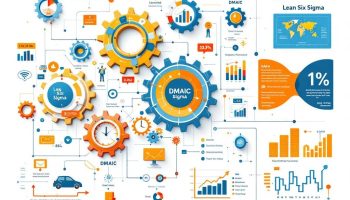
Modeling Business Processes for Enhanced Efficiency
Modeling a business process offers a strategic approach for organizations to boost workflow efficiency and operational transparency. Digital techniques and standardized notations create comprehensive process representations that support improvement, collaboration, and informed decision-making.
Key Takeaways
- Modern process modeling integrates sophisticated digital tools like BPMN, UML, and AI-enhanced technologies to create more accurate workflow representations.
- Standardized modeling techniques facilitate universal process comprehension across different organizational departments.
- Data-driven methodologies allow for real-time monitoring, performance optimization, and objective process insights.
- Advanced technologies like process mining and digital twins enable risk-free simulation and predictive process analysis.
- Effective process modeling can improve operational efficiency by up to 30% and accelerate organizational responsiveness.
Business process modeling transforms how you visualize and improve your operations. With proper implementation, you’ll gain clarity on workflow bottlenecks and optimization opportunities. BPMN diagrams help standardize how processes appear across your organization.
The right modeling approach connects team members from different departments through a common visual language. This eliminates confusion and creates alignment on process goals.
Data collection during modeling provides objective insights into performance metrics. You can track completion times, resource allocation, and success rates with precision rather than relying on subjective assessments.
Process simulation tools let you test changes in a risk-free environment. These digital sandboxes allow experimentation with workflow modifications before implementation, preventing costly mistakes.
Many organizations report efficiency improvements between 15% and 30% after implementing structured process modeling. The increased visibility leads to faster decision-making and reduced operational costs.
Advanced modeling techniques now incorporate process mining technology that automatically discovers actual workflows from system logs. This reveals the reality of how processes function versus how they’re designed to work.
Digital twin technology creates virtual replicas of business processes that update in real-time. This advanced approach enables predictive analysis and proactive problem-solving.
Cross-functional collaboration improves significantly when teams share standardized process models. The common reference point reduces miscommunication and accelerates project completion.
Regulatory compliance becomes easier to maintain with well-documented process models. You can quickly identify control points and verification steps to satisfy ISO standards and industry regulations.
Customer satisfaction often increases when processes are optimized through modeling. Streamlined operations reduce wait times and improve service delivery consistency.
Effective process models support knowledge transfer and training within your organization. New employees learn procedures faster when presented with clear visual representations.
“Modeling business processes is not just a tactical move but a strategic imperative, transforming workflow efficiency and fostering transparency through standardized techniques and advanced digital tools. By embracing these methodologies, organizations empower continuous improvement and data-driven decisions, unlocking the potential for enhanced performance and cross-departmental collaboration.”
Evolution of Process Modeling Techniques
Business process modeling has transformed significantly over the years, evolving from simple flowcharts to sophisticated digital representations. You’ll find that modern approaches to modeling a business process now incorporate standardized notations that create a universal language for describing workflows.
The evolution of process modeling techniques has been driven by the need for clearer communication and more efficient process management. Today’s standardized notations include BPMN (Business Process Model and Notation), UML (Unified Modeling Language), EPC (Event-driven Process Chain), Petri Nets, and traditional flowcharts. Each offers unique advantages when modeling a business process for different organizational needs.
Advancements in Process Modeling Methodologies
Contemporary process modeling has shifted toward a more objective, quantitative approach using real-time event log data. This data-driven methodology allows you to:
- Create more accurate representations of actual workflows
- Identify bottlenecks and inefficiencies through concrete metrics
- Validate process models against actual performance data
- Monitor process execution in real-time
- Implement continuous improvement cycles based on solid evidence
Hierarchical decomposition has become a cornerstone technique when modeling a business process, allowing you to break down complex processes into manageable sub-processes. This approach helps improve project communication and makes intricate workflows more accessible to all stakeholders.
The integration of master data has enriched process models with contextual information, providing deeper insights into how processes interact with organizational resources. When modeling a business process with master data, you gain a more comprehensive understanding of relationships between processes, systems, and people.
Standardized symbols have facilitated universal process comprehension, enabling teams to quickly grasp process flows regardless of their technical background. This standardization has proven especially valuable for project collaboration across departments and organizations.
| Era | Primary Techniques | Key Characteristics | Benefits |
|---|---|---|---|
| Traditional | Flowcharts, Process Maps | Simple visualization, manual documentation | Basic process understanding |
| Standardized | BPMN, UML, EPC | Formal notation, consistent representation | Improved communication, reduced ambiguity |
| Data-Driven | Process Mining, Digital Twins | Event log analysis, real-time monitoring | Objective insights, performance optimization |
| Intelligent | AI-enhanced modeling, Predictive analysis | Machine learning integration, automated improvements | Proactive optimization, continuous adaptation |
Modeling a business process today often involves process optimization methods that wouldn’t have been possible in earlier eras. The evolution continues as technologies like artificial intelligence and machine learning further enhance modeling capabilities.
Recent studies reveal that effective process modeling can improve operational efficiency by as much as 30%, showcasing the important role of clear workflows in modern business strategy.
hbr.org
Digital Transformation and BPM
Business process modeling forms the foundation for successful digital transformation initiatives across organizations. When properly implemented, process modeling identifies inefficiencies, eliminates redundancies, and uncovers automation opportunities that transform how your business operates. This approach to modeling a business process centralizes critical information, making it accessible for dynamic change management while supporting customer-centric service design.
The market for business process modeling solutions continues to expand rapidly. Current projections show growth from $14.4 billion to $20.84 billion by 2025, with further expansion to $68.69 billion anticipated by 2034. This surge reflects the increasing recognition of process modeling as an essential component in organizational effectiveness.
Hyper-Automation and Emerging Technologies
Modern business process modeling integrates seamlessly with hyper-automation technologies. By modeling a business process thoroughly, you create the blueprint for implementing:
- Robotic Process Automation (RPA) to handle repetitive tasks
- Artificial Intelligence to introduce predictive optimization
- Process Mining to analyze real workflow patterns
- Digital Twin technology to simulate process changes
Low-code/no-code platforms now enable faster process configuration without extensive technical knowledge. When modeling a business process through these tools, you’ll find implementation happens more rapidly while remaining flexible for future changes. Organizations implementing these integrated approaches have reported operational cost reductions up to 30%, explaining why the automation segment is projected to grow at a 21.6% CAGR between 2025-2034.
Effective process modeling enhances cross-departmental collaboration by creating visual representations everyone can understand. This transparency proves invaluable when working on collaborative projects that span multiple teams. The visibility gained through comprehensive modeling makes it easier to identify potential roadblocks before they impact operations.
The applications for business process modeling span virtually every department. Financial processes benefit from clear documentation and control points. Supply chains gain optimization through end-to-end visibility. HR streamlines recruitment when every step is mapped. Regulatory compliance becomes manageable with documented processes. Marketing departments improve campaign execution through structured lifecycle management.
When modeling a business process, consider integration with existing systems to maximize value. This approach creates opportunities for continuous improvement by establishing baseline performance metrics against which future changes can be measured.

Hyper-Automation and Emerging Technologies
The business world is rapidly evolving with hyper-automation transforming how you approach modeling a business process. This convergence of technologies—including RPA, AI, Process Mining, and Digital Twins—creates powerful opportunities for process optimization. When modeling a business process with these integrated tools, you’ll discover new pathways to efficiency that weren’t previously possible.
Low-code/No-code platforms have revolutionized business process modeling by enabling quick configuration without extensive programming knowledge. These platforms allow you to rapidly prototype, test, and deploy process models while maintaining the flexibility to adapt as requirements change. Your team can focus on modeling a business process accurately rather than getting bogged down in technical implementation details.
AI capabilities have particularly transformed process modeling by:
- Automatically identifying process bottlenecks through pattern recognition
- Suggesting optimized process flows based on historical performance data
- Predicting potential issues before they impact operations
- Continuously learning and adapting process models based on real-world execution
- Enhancing decision points with intelligent routing capabilities
When effectively implemented, these technologies can reduce operational costs by approximately 30% through advanced modeling of a business process. This significant reduction comes from eliminating redundancies, automating routine tasks, and optimizing resource allocation across your organization’s workflow.
Growth Trajectory in Process Automation
The process automation segment is projected to grow at an impressive 21.6% CAGR between 2025-2034, highlighting the increasing value organizations place on sophisticated process modeling. This growth reflects how crucial modeling a business process has become for maintaining competitive advantage in today’s digital landscape.
The integration of project delivery frameworks with hyper-automation technologies enables a more comprehensive approach to process modeling. By combining structured methodologies with advanced technologies, you can create models that not only document current processes but actively improve them.
Digital twins represent another frontier in process modeling, creating virtual replicas of your physical business processes. These simulations allow you to experiment with process changes in a risk-free environment before implementation. When implementing project approaches, these digital replicas provide invaluable insights that minimize disruption.
Process mining technologies extract real-time data from your existing systems, enabling fact-based modeling of a business process rather than relying on subjective interpretations. This data-driven approach ensures your process models accurately reflect operational reality and highlights opportunities for improvement that might otherwise remain hidden.

Practical Applications and Benefits
Business process modeling delivers substantial value across your organization by creating transparency and alignment between departments. When you implement process modeling, you can visualize workflows that previously existed only in scattered documentation or employee knowledge. This visibility creates a shared understanding that bridges communication gaps between technical and non-technical stakeholders.
By modeling a business process, you’ll experience tangible benefits in organizational flexibility. Companies that effectively model their processes can respond to market changes 60% faster than competitors with undocumented workflows. Your business gains the agility to adapt processes quickly while maintaining consistency in execution.
Process modeling strengthens your operational foundation in several key areas:
- Financial management – Map approval workflows, reduce processing delays, and identify cost-saving opportunities
- Supply chain operations – Visualize inventory movements, streamline order fulfillment, and reduce bottlenecks
- HR recruitment – Standardize candidate evaluation, improve onboarding efficiency, and ensure compliance
- Compliance monitoring – Document regulatory requirements, track adherence, and simplify audit preparation
- Marketing campaigns – Coordinate cross-functional activities, measure performance, and optimize resource allocation
The most significant advantage comes from continuous improvement capabilities. Process modeling allows you to analyze workflows systematically, identify inefficiencies, and implement targeted enhancements. Your organization can establish a cycle of ongoing refinement that drives incremental performance gains.
Enhanced Scalability Through Standardization
When modeling a business process, you create standardized templates that enable consistent execution regardless of volume changes. This standardization becomes crucial during growth phases when you need to maintain quality while expanding operations.
Process modeling supports your strategic planning initiatives by providing clear documentation of current-state operations. You can better identify which processes can handle increased demand and which require restructuring to accommodate growth.
| Performance Area | Average Improvement |
|---|---|
| Process cycle time | 25-50% reduction |
| Error rates | 35-70% reduction |
| Compliance violations | 40-80% reduction |
| Employee onboarding time | 30-60% reduction |
| Customer satisfaction | 15-40% increase |
These improvements stem from modeling a business process with precision and implementing the insights gained. Your organization benefits from both the documentation process itself and the optimization opportunities it reveals.
When properly executed, process modeling facilitates project collaboration by creating a common visual language that aligns diverse team members around shared objectives. This alignment reduces misunderstandings and accelerates implementation of process improvements.
Companies that effectively model their processes can respond to market changes 60% faster than competitors with undocumented workflows.
forbes.com
Implementation and Future Outlook
Successful business process modeling implementation requires a strategic approach to maximize returns. When modeling a business process, you’ll need to consider organizational readiness, technical infrastructure, and stakeholder buy-in. You can achieve optimal results by following a structured implementation roadmap that balances quick wins with long-term transformation.
Key Implementation Considerations
Begin your process modeling journey by establishing clear objectives aligned with business goals. Your success depends on selecting the right modeling methodology and tools that match your organizational complexity. Consider these essential implementation factors:
- Governance Framework: Establish clear ownership, roles, and decision-making authority for process modeling a business process initiative.
- Technical Integration: Ensure compatibility with existing systems like CRM, ERP, and legacy applications.
- Change Management: Develop comprehensive training programs to build modeling capabilities across teams.
- Data Quality: Implement data validation protocols to ensure accuracy in process models.
- Measurement Metrics: Define KPIs to track implementation success and process improvements.
The future of process modeling shows promising advancements that will transform how organizations optimize workflows. Effective project leadership will be crucial as technologies evolve. You can expect to see AI-powered predictive analytics that anticipate process bottlenecks before they occur and suggest optimization pathways.
Cloud-based collaborative modeling platforms will enable real-time cross-functional input when modeling a business process. This facilitates better project collaboration across departments and geographic locations. Advanced simulation capabilities will allow you to test process changes in virtual environments before implementation.
For maximum ROI, integrate your process modeling efforts with strategic planning initiatives. This alignment ensures that process improvements directly support organizational objectives. The typical timeline for realizing benefits ranges from 3-6 months for tactical improvements to 12-18 months for strategic transformation.
When implementing process modeling initiatives, you’ll need to establish a robust project communication plan to keep stakeholders informed and engaged. This transparency helps overcome resistance to change and builds organizational momentum. Expected ROI metrics include:
| Metric | Typical Improvement |
|---|---|
| Process cycle time | 20-30% reduction |
| Error rates | 25-40% reduction |
| Resource utilization | 15-25% improvement |
| Customer satisfaction | 10-20% increase |
| Compliance adherence | 30-50% improvement |
Remember that modeling a business process isn’t a one-time project but an ongoing capability that requires continuous refinement. Organizations that establish centers of excellence for process modeling achieve significantly better results than those treating it as a tactical initiative.






